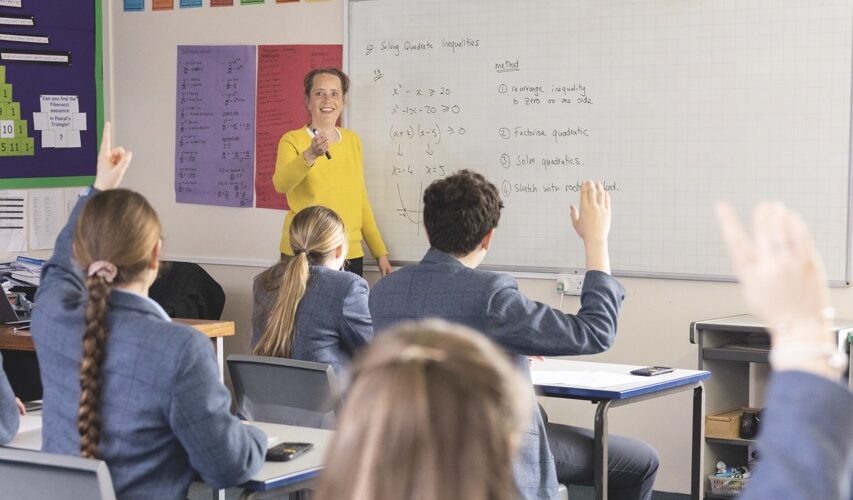With a recent report highlighting a growing divide between boys and girls in STEM subjects, Charlotte Phillips gauges the reaction of local educational leaders – and hears about their inspirational work
While some A-level subjects – maths, physics and computing among them – are still dominated by boys, girls’ participation in STEM subjects (science, technology, engineering and mathematics) is soaring.
Take chemistry and biology A-levels, where the proportion of entries from girls outnumbers those from boys. And when students move on from school, the trend continues: the 2023/24 UK medical student intake was 60% female, for instance.

At St Mary’s School, STEM success starts with understanding how girls think
So, the recent unveiling of the latest TIMSS results came as a shock to many STEM leaders. TIMSS – which stands for Trends in International Mathematics and Science Study – has been going since 1995 and observes how children from 66 participating countries, including England, perform in maths and science for years 5 and 9, as well as comparing what’s taught and how.
The initial results from the latest survey, carried out in 2023, were published towards the end of last year and made for reassuring reading, showing that pupils in England were performing well above average in maths and science.
It was the second batch of data, released in March, that caused ripples in the educational world and beyond. Its findings showed boys in England doing far better in STEM subjects than girls – particularly in year 9, where the gap in maths between boys and girls was wider than in any other country taking part in the research.
Unsurprisingly, there have been calls to investigate what’s going on and whether what we’re seeing is a one-off or an early warning sign – the canary in the calculus – that something fundamental is happening to girls’ enthusiasm for STEM subjects.
Critical thinking
For head of maths Will Taylor and deputy head of maths Vesna Kadelburg at The Perse School, the clear message is: ‘don’t panic’. Dramatic as the figures sound, they may not signal a long-term trend. “The gap is bigger than in 2019, but it’s only one data point after a long history of broadly equal performance for boys and girls,” they note.
As they stress, these are pupils whose education was significantly disrupted by the Covid-19 pandemic, which included missing out on the national SATs usually taken in year 6. So, are we looking at the situation in the wrong way?
“The change might be an indicator of schools doing a great job. For 16 years, the gap was not significant. Then, when we measure those pupils who were in late primary school or early secondary school during Covid-19 school closures, we see a big gap. Could this be evidence that schools really are helping close this gap?” suggest the STEM experts at The Perse.
“It’s also worth noting that the study doesn’t show a difference in ability, but a difference in performance on that test. Our feeling is that there is no inherent difference in the ability of boys and girls. I guess that’s why we might worry about differences in performance.”
Confidence counts
There are other factors at play. One of the points highlighted by the report is that boys tended to be more confident about their maths skills than girls.
Helping girls to develop similar levels of confidence could be an essential part of the solution, say various schools. This can be challenging because it means learning to live with and even embrace getting some things wrong.
For Faye Shane, head of senior school at Stoke College and a maths teacher with more than 25 years in the profession, shedding that fear of failure is crucial. “With maths, you must make mistakes and learn from them,” she says. But getting the wrong answer – particularly in class – can feel daunting. “I think [girls] feel that peer pressure a bit more,” she adds.
“Risk-taking can be something girls find less attractive because they work more collaboratively and may fear judgement for getting something wrong,” confirms Hannah Helliar, head of St Mary’s School.
Fortunately, schools in our area are brilliant at finding ways of breaking through the confidence barrier. At St Mary’s, it all starts with listening to students. “Our head of maths surveyed the girls recently to ask questions about their experience of maths, how they feel about it and how confident they feel about their future performance,” explains Hannah. “The information is then used to track how girls’ perceptions change during the academic year.”

St Mary’s School designs lessons to match the thinking of students
Lessons are also planned to be exciting and challenging – and mistakes are relished as part of the learning process. “One of the things we focus on at St Mary’s is creating a positive response to feedback,” Hannah continues. “We focus on those areas where the girls have made minor slips and where we can encourage them to think positively about that feedback and focus on how to get it right next time. That feeds into their confidence in the subject, which in turn builds a greater likelihood of success.”
At Stoke College, mistakes are shared, discussed and turned into a learning tool. “When we learn something for the first time, we work using mini whiteboards,” says Faye Shane. “We say: ‘Let’s try it out, see how this goes and make all our mistakes now while it’s easy to change.’”
Understanding that it’s OK to make mistakes requires a different mindset that can take some adjustment, she explains. “That’s quite a change of culture for a lot of children and can be a huge thing, particularly with girls, who don’t want to make mistakes – but you can’t move forward until you know what you are doing wrong.”
Running girls-only events can make a difference. Girls at The Perse can sign up for competitions and clubs including a Maths Olympiad and coding club. The school has also rethought the language it uses when trying to recruit students to STEM subjects, such as further maths, to increase their appeal to girls. “The interventions included changing the way we describe the course to students and also how we describe the kind of pupil who will succeed at the course. We now talk less about standards of attainment and more about learning characteristics. Rather than ‘you need a grade 8 or better’, we may say ‘students who are consistent about seeking help to overcome gaps in understanding are likely to be successful’,” says the school.
Strategising for success
Whether the TIMSS results are a mere blip or a long-term trend, schools in the Cambridgeshire area are well prepared, with a range of imaginative strategies designed to encourage every student – regardless of gender – with a talent for STEM to flourish. “We talk about creating an environment at school where risk-taking is encouraged and learning from mistakes is a superpower,” says Hannah Helliar at St Mary’s School.
“It’s all about having that balance between stretch and challenge – a teaching approach that focuses on providing all pupils with tasks that push them to reach their full potential – while also maintaining enjoyment and satisfaction.”
Home help
If your child is struggling with STEM and you’re wondering how to support them outside school, here’s advice from the experts…
Promote its benefits
Be enthusiastic about the importance of STEM subjects.

Faye Shane at Stoke College supports A-level students with their maths work
Be positive
For instance, if numbers aren’t your forte either, try saying: ‘Even if I wasn’t good at maths, it doesn’t mean you can’t be.’
Instil key qualities
Encourage determination and resilience in your child.
Make it fun
Organise games such as treasure hunts, where every clue is number-based.
Normalise it
Make maths and science part of day-to-day life – through cooking, for example, which involves weighing and measuring.
Seek advice
Try contacting your child’s STEM teachers, who can offer ideas for sensible, well-pitched activities to support their progress.
Here are five schools that have created innovative ways they’re inspiring everyone in STEM lessons.

